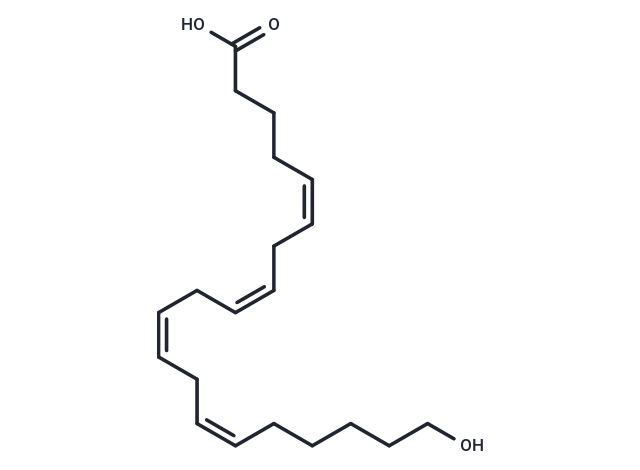Shopping Cart
- Remove All
 Your shopping cart is currently empty
Your shopping cart is currently empty

20-HETE promotes cell proliferation and migration in cancer and can be used to study prostate tumors and cardiac hypertrophy by activating the protein kinase C pathway to increase FBXO10 expression.20-HETE promotes cell proliferation and migration in cancer and can be used to study prostate tumors and cardiac hypertrophy by activating the protein kinase C pathway.

| Pack Size | Price | Availability | Quantity |
|---|---|---|---|
| 100 μg (312.04 μM * 1 mL in Ethanol) | $498 | In Stock | |
| 1 mg (312.04 μM * 10 mL in Ethanol) | $1,198 | In Stock | |
| 5 mg (312.04 μM * 50 mL in Ethanol) | $2,450 | In Stock |
| Description | 20-HETE promotes cell proliferation and migration in cancer and can be used to study prostate tumors and cardiac hypertrophy by activating the protein kinase C pathway to increase FBXO10 expression.20-HETE promotes cell proliferation and migration in cancer and can be used to study prostate tumors and cardiac hypertrophy by activating the protein kinase C pathway. |
| In vitro | 17-ODYA (1 μM) increased the activity of large-conductance Ca(2+)-activated K+ channels, and this effect was reversed by 20-HETE (10 nM). 20-HETE (1-1000 nM) reduced the diameter of isolated perfused small renal arteries in rats by approximately 15%, and TEA (1 mM) blocked the vasoconstrictor response to 20-HETE (100 nM)[1]. |
| In vivo | 20-HETE contributes to DHT-induced vascular remodeling, independent of blood pressure elevation[2]. |
| Alias | 20-hydroxy Arachidonic Acid |
| Molecular Weight | 320.47 |
| Formula | C20H32O3 |
| Cas No. | 79551-86-3 |
| Smiles | C(=C\C/C=C\C/C=C\CCCCCO)\C/C=C\CCCC(O)=O |
| Relative Density. | 0.985g/cm3 |
| Storage | store at low temperature | Powder: -20°C for 3 years | In solvent: -80°C for 1 year | Shipping with blue ice. | |||||||||||||||||||||||||
| Solubility Information | DMSO: 2 mg/mL (6.24 mM), Sonication is recommended. Ethanol: 5 mg/mL (15.60 mM), Sonication is recommended. | |||||||||||||||||||||||||
Solution Preparation Table | ||||||||||||||||||||||||||
DMSO/Ethanol
Ethanol
| ||||||||||||||||||||||||||

Copyright © 2015-2024 TargetMol Chemicals Inc. All Rights Reserved.